SCORING
A goal is credited to the team attacking the basket into which the ball has entered as follows:
- A goal from a free throw counts one (1) point;
- A goal from the two-point field goal area counts two (2) points;
- A goal from the three-point field goal area counts three (3) points.
Every team has 24 seconds to complete its attempt to score a basket. If the team with the ball exceeds this time limit, then the ball and the right of play is granted to the opposing team.
DRIBBLING
A player may wheel the chair and bounce the ball simultaneously, however, if the ball is picked up and/or placed on the player’s lap, he/she is only allowed to push twice before they are obligated to shoot, pass, or dribble the ball again. There is no double dribble rule in wheelchair basketball. A traveling violation occurs if the player takes more than two pushes while in possession of the ball without dribbling. A player is not allowed to touch the playing surface with his or her feet while in possession of the ball.
FOULS
The wheelchair is considered part of the player’s body in relation to establishing responsibility for contact on the court in the case of charging, blocking, going out of bounds, and other violations. An offensive player may not remain in the key area for more than three seconds. In addition to the technical fouls that may be assessed from time to time as in stand up basketball, a player lifting his/her legs to gain an advantage or lifting out of his/her chair is given a technical foul. The player must remain firmly seated in his/her chair and must not use his/her lower limbs to steer the chair or gain an unfair advantage. In the event that a player falls out of his/her chair, a referee may stop the play if in his/her opinion the player is at risk of being injured, otherwise play will continue. On an inbounds play, the offensive player is not allowed to go into the key until the ball is handed to the inbounding player by the referee.
VIDEO
